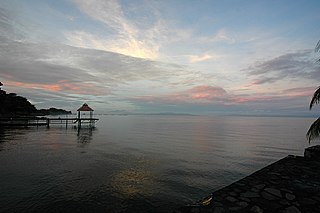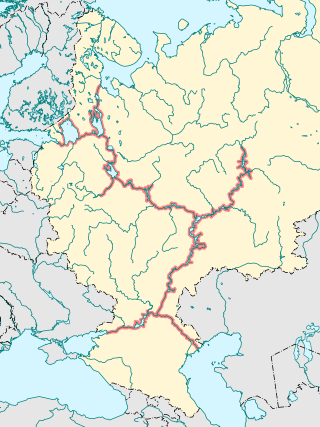
Barge typically refers to a flat-bottomed vessel which does not have its own means of mechanical propulsion. Original use was on inland waterways, while modern use is on both inland and marine water environments. The first modern barges were pulled by tugs, but on inland waterways, most are pushed by pusher boats, or other vessels. The term barge has a rich history, and therefore there are many types of barges.

Canals or artificial waterways are waterways or engineered channels built for drainage management or for conveyancing water transport vehicles. They carry free, calm surface flow under atmospheric pressure, and can be thought of as artificial rivers.

Lake Nicaragua or Cocibolca or Granada is a freshwater lake in Nicaragua. Of tectonic origin and with an area of 8,264 km2 (3,191 sq mi), it is the largest fresh water lake in Central America, the 19th largest lake in the world and the tenth largest in the Americas, slightly smaller than Lake Titicaca. With an elevation of 32.7 metres (107 ft) above sea level, the lake reaches a depth of 26 metres (85 ft). The intermittent Tipitapa River feeds Lake Nicaragua when Lake Managua has high water. Lake Cocibolca is between two other bodies of water, on top is Lake Xolotlán and below is the San Juan River. These body of waters complete the largest International Drainage Basin in Central America.

The Nicaraguan Canal and Development Project, informally the Nicaragua Canal was a proposed shipping route through Nicaragua to connect the Caribbean Sea with the Pacific Ocean. Scientists were concerned about the project's environmental impact, as Lake Nicaragua is Central America's key freshwater reservoir while the project's viability was questioned by shipping experts and engineers.

The Panama Canal is an artificial 82-kilometer (51-mile) waterway in Panama that connects the Atlantic Ocean with the Pacific Ocean, cutting across the Isthmus of Panama, and is a conduit for maritime trade. Locks at each end lift ships up to Gatun Lake, an artificial fresh water lake 26 meters (85 ft) above sea level, created by damming up the Chagres River and Lake Alajuela to reduce the amount of excavation work required for the canal. Locks then lower the ships at the other end. An average of 200,000,000 L (52,000,000 US gal) of fresh water is used in a single passing of a ship. The canal is threatened by low water levels during droughts.

The St. Lawrence Seaway is a system of locks, canals, and channels in Canada and the United States that permits oceangoing vessels to travel from the Atlantic Ocean to the Great Lakes of North America, as far inland as Duluth, Minnesota, at the western end of Lake Superior. The seaway is named for the St. Lawrence River, which flows from Lake Ontario to the Atlantic Ocean. Legally, the seaway extends from Montreal, Quebec, to Lake Erie, and includes the Welland Canal. Ships from the Atlantic Ocean are able to reach ports in all five of the Great Lakes, via the Great Lakes Waterway.

The Great Lakes Waterway (GLW) is a system of natural channels and artificial locks and canals that enable navigation between the North American Great Lakes. Though all of the lakes are naturally connected as a chain, water travel between the lakes was impeded for centuries by obstacles such as Niagara Falls and the rapids of the St. Marys River.

A waterway is any navigable body of water. Broad distinctions are useful to avoid ambiguity, and disambiguation will be of varying importance depending on the nuance of the equivalent word in other ways. A first distinction is necessary between maritime shipping routes and waterways used by inland water craft. Maritime shipping routes cross oceans and seas, and some lakes, where navigability is assumed, and no engineering is required, except to provide the draft for deep-sea shipping to approach seaports (channels), or to provide a short cut across an isthmus; this is the function of ship canals. Dredged channels in the sea are not usually described as waterways. There is an exception to this initial distinction, essentially for legal purposes, see under international waters.

A pusher, pusher craft, pusher boat, pusher tug, or towboat, is a boat designed for pushing barges or car floats. In the United States, the industries that use these vessels refer to them as towboats. These vessels are characterized by a square bow, a shallow draft, and typically have knees, which are large plates mounted to the bow for pushing barges of various heights. These boats usually operate on rivers and inland waterways. Multiple barges lashed together, or a boat and any barges lashed to it, are referred to as a "tow" and can have dozens of barges. Many of these vessels, especially the long distance, or long haul boats, include living quarters for the crew.

The Intracoastal Waterway (ICW) is a 3,000-mile (4,800 km) inland waterway along the Atlantic and Gulf of Mexico coasts of the United States, running from Massachusetts southward along the Atlantic Seaboard and around the southern tip of Florida, then following the Gulf Coast to Brownsville, Texas. Some sections of the waterway consist of natural inlets, saltwater rivers, bays, and sounds, while others are artificial canals. It provides a navigable route along its length without many of the hazards of travel on the open sea.

Panamax and New Panamax are terms for the size limits for ships travelling through the Panama Canal. The limits and requirements are published by the Panama Canal Authority (ACP) in a publication titled "Vessel Requirements". These requirements also describe topics like exceptional dry seasonal limits, propulsion, communications, and detailed ship design.

The Industrial Canal is a 5.5-mile (8.9 km) waterway in New Orleans, Louisiana, United States. The waterway's proper name, as used by the U.S. Army Corps of Engineers and on NOAA nautical charts, is Inner Harbor Navigation Canal (IHNC). The more common "Industrial Canal" name is used locally, both by commercial mariners and by landside residents.

The inland waterways of the United States include more than 25,000 mi (40,000 km) of navigable waters. Much of the commercially important waterways of the United States consist of the Mississippi River System—the Mississippi River and connecting waterways.

The Sacramento Deep Water Ship Channel is a canal from the Port of Sacramento in West Sacramento, California, to the Sacramento River, which flows into San Francisco Bay. It was completed by the United States Army Corps of Engineers in 1963. The channel is about 30 feet (9.1 m) deep, 200 feet (61 m) wide, and 43 miles (69 km) long.

The McClellan–Kerr Arkansas River Navigation System (MKARNS) is part of the United States inland waterway system originating at the Tulsa Port of Catoosa and running southeast through Oklahoma and Arkansas to the Mississippi River. The total length of the system is 445 miles (716 km). It was named for two senators, Robert S. Kerr (D-OK) and John L. McClellan (D-AR), who pushed its authorizing legislation through Congress. The system officially opened on June 5, 1971. President Richard M. Nixon attended the opening ceremony. It is operated by the Army Corps of Engineers (USACE).
The Waterways Journal Weekly is the news journal of record for the towing and barge industry on the inland waterways of the United States, chiefly the watershed of the Mississippi River and its tributaries and the Gulf Intracoastal Waterway. Known as The Riverman’s Bible, the periodical has been published continuously from St. Louis, Missouri, since 1887. Published by H. Nelson Spencer and his son Nelson Spencer Jr., it is the only American maritime publication that focuses exclusively on the inland waterways of the United States, and is one of the few remaining family-owned, advertiser-supported trade weeklies of any description.

The West Coast Canal or National Waterway No 3 is a 205 km (127 mi) long inland navigational route located in Kerala, India, which runs from Kollam to Kottapuram. It was declared a National Waterway in 1993. In addition to the main stretch, Champakara and Udyogmandal canals are navigable and connect the industrial centers of Kochi to Kochi port Inland Waterways Authority of India (IWAI) under the Ministry of Shipping is coordinating the task for developing, monitoring and administering national waterways. It is the first National Waterway in the country with 24-hour navigation facilities along the entire stretch. It has been extended to Kozhikode by the National Waterways Act, 2016. The National Waterway 3 mainly passes through the previous Thiruvananthapuram–Shoranur canal.

Attempts to build a canal across Nicaragua to connect the Atlantic Ocean with the Pacific Ocean stretch back to the early colonial era. Construction of such a shipping route—using the San Juan River as an access route to Lake Nicaragua—was first proposed then. Napoleon III wrote an article about its feasibility in the middle of the 19th century. The United States abandoned plans to construct a waterway in Nicaragua in the early 20th century after it purchased the French interests in the Panama Canal, which has served as the main connecting route across Central America since its completion.

The Unified Deep Water System of European Russia or UDWS is a system of inland waterways in Russia linking the White Sea, the Baltic Sea, the Volga River, Moscow, the Caspian Sea and—via the Sea of Azov—the Black Sea. In 2010, UDWS carried 70 million tons of cargo and 12 million passengers, making up two-thirds of overall inland waterway traffic volume in Russia. There are 60 common-use ports and quays in the UDWS, including three international ports, so Moscow is sometimes called "the port of the five seas".
The Jefferson Seaway was a proposed deep-draft ship channel to be created in Jefferson Parish, Louisiana, that would establish a route between the Mississippi River at Westwego and the Gulf of Mexico near Grand Isle. The Mississippi River provided the only deep-water access to New Orleans and its neighboring ports. In the mid-20th century, the creation of alternate routes was considered, including the Mississippi River-Gulf Outlet (MR-GO), which was ultimately selected, funded and constructed. The Jefferson Seaway, sometimes referred to as the Arrow to the Americas, the Mississippi Valley Seaway Canal, the Tidewater Ship Canal and the Barataria Canal, was also under consideration but ultimately was never constructed as a deep-draft channel.

















